Home
Repair And Restoration
DIY Fork Stanchion Half Gaiters
Bodge Date - 22 December 2016
By Ren Withnell
So you ride a motorcycle, primarily on the road. At the front of your bike you have the suspension. 2 chrome plated tubes (stanchions) that slide in and out of 2 alloy fork legs. If the chromium plating on the stanchions gets damaged then as the stanchion slides in and out of the fork leg it tears the seal that keeps the fork oil in the tubes. Not only is this an MOT failure it will also lead to poor damping and therefore handling. And them there stanchions ain't cheap to replace.
But what, prey tell, could damage that (not very) thick luscious layer of chrome? Wear plays it's part but the biggest cause of damage are stones thrown up from other road users. Look at the front of any high mileage executive car and you'll see a series of small chips, usually on the leading edge of the bonnet. The tyres of other road users spit out the odd stone that's picked up from the tarmac and ejected at high velocity towards your motorcycle due to centrifugal forces.
OH mercy me! I must protect my delicate chrome stanchions from such an onslaught. Fear not dear reader, I am here to help and it won't cost you much.
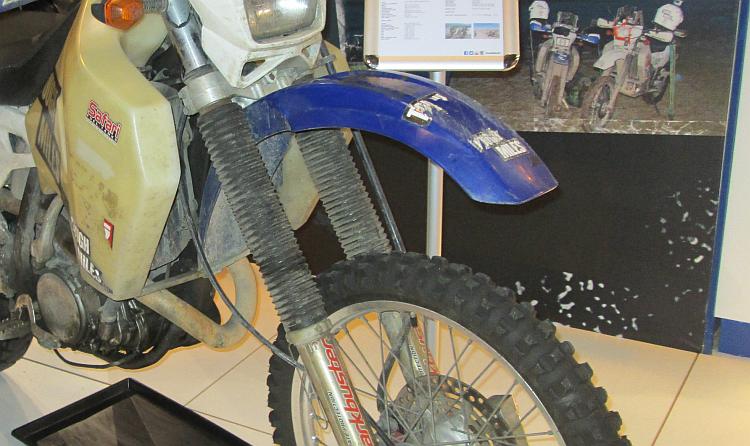 Fork Gaiters?
Fork Gaiters?
Fork gaiters are cheap enough. Rubber or plastic flexible tubes cover the whole stanchion providing maximum protection. Pah! They're great and offer the best safeguard but you'll need to remove your forks to fit them, unless they're well designed they can trap moisture that causes rust and you can never keep an eye on the stanchion hidden beneath them. There is a better solution.

Be amazed, be in awe!
Behold! Ren's (not really) patented stanchion protectors. Simply cut up an old bicycle inner tube and apply thusly to the forks and Bob is your father's brother. Nothing more than an old punctured inner tube and a handful of zip ties is required.
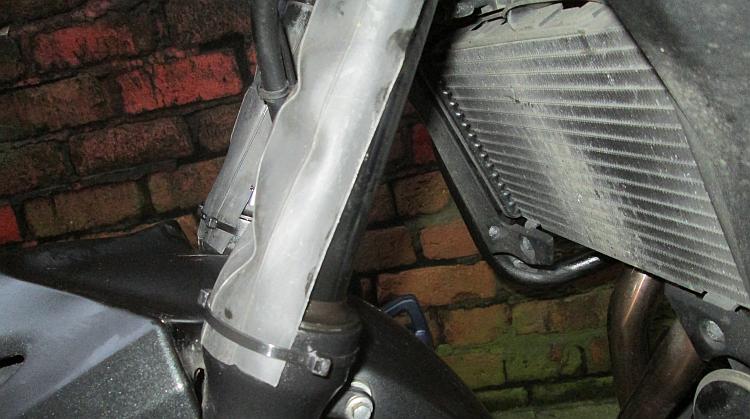 Ingenius and a work of art indeed.
Ingenius and a work of art indeed.
Any wayward high velocity road aggregate or other such chrome plate damaging materials will simply be met with a thin layer of cheap rubber rather than your delicate and expensive forks. You can now ride without fear behind BMWs and Audis and even the worst aspects of road salt will be kept at bay. Not only this you can easily clean and inspect your stanchions to ensure they're in tip top pristine order.
But what of those natty little plastic protectors seen on many modern motorcycles?
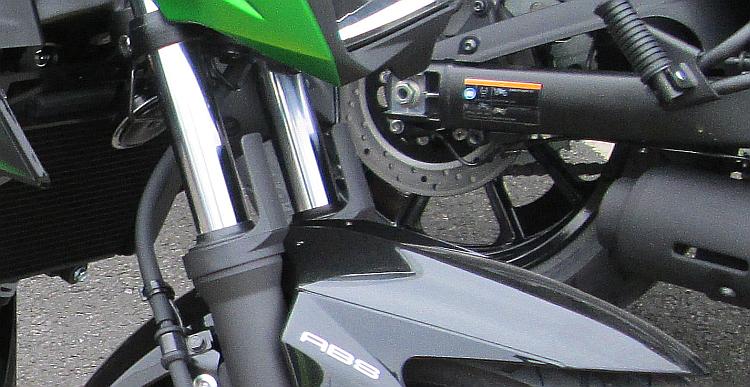 Yeah OK they're alright but not great.
Yeah OK they're alright but not great.
Pah! Yes yes they do protect the small and most active part of the stanchion but not all of it. I know I'd much rather be using Ren's (not really) patented stanchion protectors. All you need to do is send me £4,598 by Paypal and I'll show you how to do this for yourself. In fact at that price I'll come and fit them too. (Applies to UK residents only, no warranty given or implied, prices subject to change, actual item may very from those shown, it may not work, doesn't apply to BMW Telelever, Ren cannot be held responsible for the purchaser's stupidity, for goodness sake get a life)

Even the CBF 125 has them.
 OK, maybe this doesn't need my gaiters...
OK, maybe this doesn't need my gaiters...
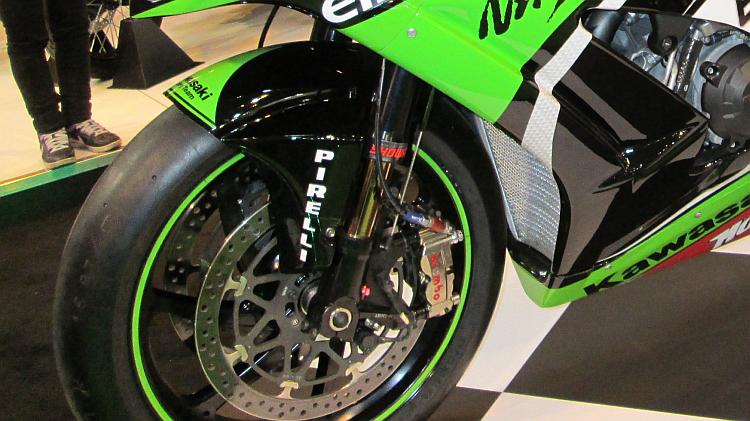 ...or this...
...or this...
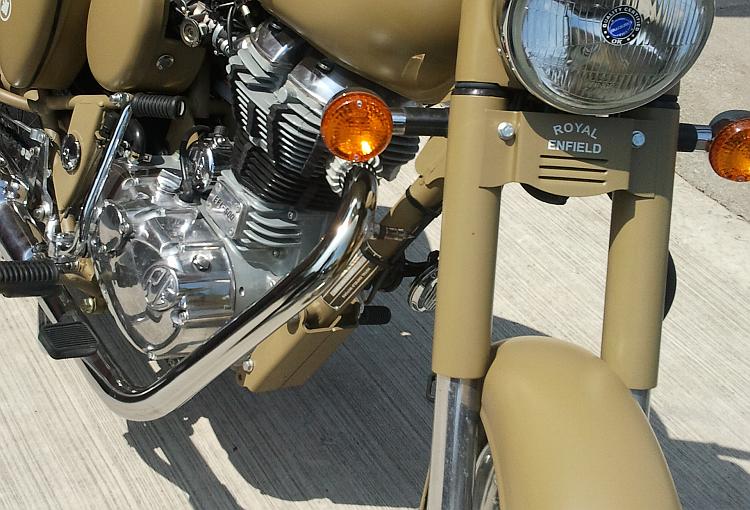 ..or this...DAMMIT! If Enfield are so well protected then why can't Honda do the same?
..or this...DAMMIT! If Enfield are so well protected then why can't Honda do the same?
Reader's Comments
Ian Soady said :-
You knew I'd be along sooner or later....
This was a dodge used by some trials riders in the 1950s when bikes were bikes and men were giants. I think (though I can't find a picture) that it was first used by the great Sammy Miller who went to incredible lengths to lighten his Ariel 500 (GOV 132). It was said to weigh in at around 115 Kg in its final form (the standard bike would have been 30 Kg more).
This picture is Miller on probably an earlier incarnation of the Ariel with conventional gaiters.
I once rode in the same trial as he did (to say I competed with him would be extremely misleading). He flew up a slimy river bank as if it was a main road. When I attempted it I managed to fall off after about 6 feet.
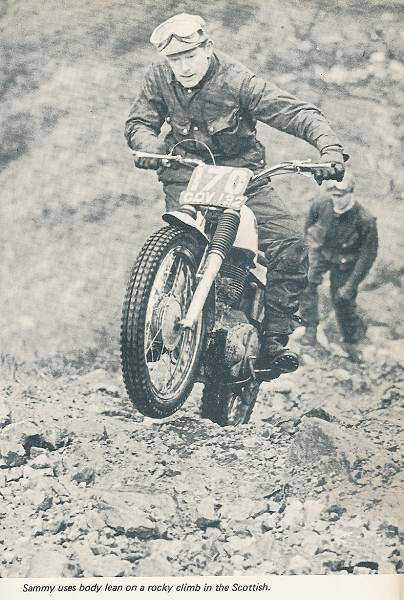 28/12/2016 10:51:56 UTC
28/12/2016 10:51:56 UTC
Ren - The Ed said :-
DAMN!! So what you're trying to tell me Ian is I'm not the first person to invent this? Oh my goodness, will I ever have an original idea?
As for people making things look easy. About 10 years ago while riding with friends in Scotland there was one lad who was always super fast but made it look super easy. That was one of several turning points in my riding career. That and several other events made me decide I was coming at motorcycling all wrong. I'm not fast and as such I began to encourage myself to stop trying to be fast.
My motorcycling has improved and the pleasure I gain from motorcycling has increased. I can press on a little when the situation and the mood take me but I'd rather be cruising most of the time.
28/12/2016 18:43:26 UTC
Alan said :-
Been reading how to fit after market gaiters, and it seems quite a complicated process. Would doing a variation of Ren's patented technique be much different from fitting as per instructions, to whit, instead of dismantling the front of the bike, slice each gaiter length ways up the back, fit over the fork, push the ends into position and pull as tight as possible at the back and secure with cable ties. Apply 406 o'ring cement (the stuff in make your own O ring kits) along the line of the cut, let it harden and redo the two end pieces if required. If 406 can hold orings together under extremes of pressure and temperature it should manage a rubber boot at environmental conditions. What do you think?
28/12/2016 23:20:41 UTC
Ren - The Ed said :-
To be honest Alan that sounds just as difficult as dropping the forks out and sliding the gaiters over the top as you'd normally expect.
I don't know how mechanically experienced you are Alan. Personally I find taking the front wheel off and slipping out a fork leg is quite easy. That said the first time I did it I was terrified and bemused. I took the headlight off thinking I'd need to do that! Wires everywhere.
The gaiters will inevitably be weaker too. I think your plan would work but I think it'll be best done in the usual way.
29/12/2016 07:23:28 UTC
Ian Soady said :-
That technique (gluing) is used for CV boots on cars to avoid dismantling all the transmission and seems to work well, but those gaiters are designed for the job and arrive already split.
www.autopoweronline.co.uk/Product/cv%20boot%20split%20inner%20x1-295/REPAIR-INNE...
29/12/2016 10:46:05 UTC
Ian Soady said :-
Brief research tells me it was Gordon Jackson not Miller who used the inner tubes - this pic is of the 1961 SSDT winning bike. Jackson won with a single dab.
You can also see a bit of lorry inner tube being used to shield the carb. Useful things inner tubes!
 29/12/2016 11:04:05 UTC
29/12/2016 11:04:05 UTC
Ian Soady said :-
This is the historic single dab......
 29/12/2016 11:04:53 UTC
29/12/2016 11:04:53 UTC
Alan said :-
Thanks Ren. Most of my mechanical destroy it yourself experience has been with cars and marine equipment, I'm not a mechanic or engineer so not a professional. I was thinking of doing that to my bike when I get it in 3 weeks or so, a bit more aesthetically pleasing than the inner tubes and not a warranty violator. I read an online guide to fitting gaiters to a BMW, I think it was and by step 7 in the procedure my spanners were back in the mental toolbox with a massive padlock on it. We use a lot of glued O' rings in various hydraulic systems at work as some of them are so old and built to defunct standards that no-one makes them any more.
Ian, thanks for the link about CV joint gaiters. One of my quadbike CV joint gaiters is currently held together with gaffer tape and I wasn't wanting to lie on the cold ground dismantling the whole lot to fit a new one.I think i will be doing some measuring when I get home next month.
29/12/2016 14:54:48 UTC
Ren - The Ed said :-
Is it worthwhile getting the shop to fit the gaiters? There's no arguments about warranty then either.
One single dab? I'd have stopped at the bottom, got off and said "Screw that!" As for a small piece of truck inner tube that looks more like half of it. Can't do the cooling much good. Loving the whole cloth cap and Barbour jacket thing, my how times have changed.
29/12/2016 20:57:00 UTC
tahrey said :-
Apparently the early CG125 models had full (metal!) guards around the stanchions like on that Enfield. They soon ditched them due to the cost, and how in their main target market for the bike (basic transport around rainforesty developing countries with a lacking sealed-surface infrastructure) stone chippings thrown up at high speed weren't anywhere near as much of a concern as moisture retention...
29/10/2018 14:38:21 UTC
Ren - The Ed said :-
Moisture retention within gaitors or full shrouds is a real issue. Guards tend not to be sealed tightly but even so it provides an area where condensation forms and remains.
I think the perfect solution would be a metal guard that wraps around say 3/4 of the stanchion. It would offer excellent protection while allowing circulation and easy inspection.
Of course in countries with an average speed of say 15mph stanchion protection probably isn't much of an issue.
29/10/2018 18:37:34 UTC
tahrey said :-
Well, I've done what I can to fill the (thankfully very few, very small) pits on the active part of mine, liberally painted over the chips on the rest of the upper and lower legs, replaced the seals and got everything back together and in the bike with full size el cheapo Wemoto gaiters in place... we will see what happens within them moisture-wise over the days to come.
Personally I'm of the mind that if they actually have created a sealed environment within them (a good fit anyway, but tied on reasonably tight top and bottom with zipties), then there shouldn't ever be any more potentially-condensing moisture within them than there was when they were installed, which was in a somewhat cool, not particularly damp atmosphere, so it shouldn't be a massive problem. And if the main potential issue does come to pass - the seals leaking again - the areas most at risk of rusting will be covered with a thin protective layer of oil anyway. And they're now completely proof against flying stones.
But, I'm prepared to be wrong, especially given all the other grief I've run into in what was meant to be a simple bug-fixing pre-MOT service job.
07/11/2018 22:02:24 UTC
Name
Comment
Add a RELEVANT link (not required)
Upload an image (not required) -
Uploading...
Home
Repair And Restoration